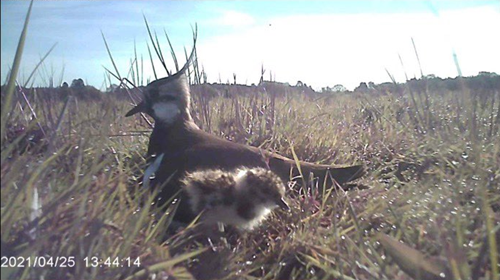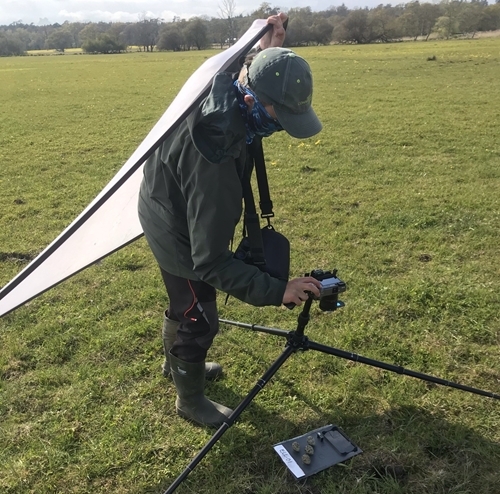|

An adult lapwing and a chick (copyright Exeter University)
Lapwings use the shape of their nests and surroundings to hide from predators, new research carried out in collaboration with the Game & Wildlife Conservation Trust shows.
Like many ground-nesting bird species, lapwings are in decline due to changes in land management and high populations of predators, such as foxes and crows. Conservation projects can fail because too many eggs and chicks are eaten.
The new study, led by the University of Exeter, assessed the visibility of lapwing nests in terms of cover (also called “occlusion”) and camouflage using models that simulate the vision and viewing angles of various predators.
The findings showed that despite nesting in open fields, lapwings can hide their eggs by using small variations in the terrain, making them invisible to ground predators such as foxes, from anything more than around 1.5 metres away.

Playing ‘hide-and-seek’
The author of the paper, George Hancock, spent two years with the Wetlands Research Team at Fordingbridge-based GWCT, carrying out his research in the Avon Valley and on the trust’s arable site near Arundel in West Sussex.
He said: “Like children playing hide and seek, lapwings use cover to complement their camouflage. If a nest is properly concealed in this way, it doesn’t matter how good a predator’s vision is – they simply won’t be able to see it until they are nearly on top of it.
“Lapwings tended to choose uneven ground for their nests. They selected slightly elevated positions, reducing risk of flooding and allowing them to see predators – without being so high as to stand out to predators.
“Nests and eggs are also camouflaged – blending in with their surroundings by matching their background’s colour and pattern.”
George, who is based at the Centre for Ecology and Conservation on Exeter’s Penryn Campus in Cornwall, used smart phone 3D scanners to measure the shape and height of lapwing nests and their surroundings.
He also used specialised cameras to measure camouflage from the perspective of the lapwing’s predators (foxes, crows and raptors), which can see ultraviolet light.
“New technology is allowing us to better measure how animals see and view the world,” he explained.

George Hancock (copyright GWCT)
‘Nature’s toolkit’ can help conservation efforts
Lapwing populations have more than halved since the 1970s. The findings could help inform conservation efforts for this declining species, which is an iconic part of farmland in the UK and beyond.
“Habitat variation appears to be crucial for allowing lapwings choice in where to nest. The growth of intensive agriculture has left ground-nesting birds with poorer choices of where to nest,” George explained.
“Grazed fields provide good habitat, as long as they’re not overstocked with too many grazing animals. Tilled fields can provide really good camouflage for eggs which match the bare earth and can be concealed by the rough geometry, but might be problematic for chicks which are more exposed.”
By providing habitats that complement lapwing camouflage, George said conservation managers could use “nature’s toolkit” – in addition to direct predator control – to help lapwings breed successfully.
Lizzie Grayshon, from the GWCT Wetlands Research Team and co-author of the paper, said: “George worked alongside me in the Avon Valley as I was conducting my annual lapwing surveys and nest monitoring.
“It’s great to get a further understanding of how the local topography and habitat composition can have an effect on nest site selection.”
The study was funded by the Natural Environment Research Council and GWCT.
The paper, published in the journal Ecology and Evolution, is entitled: “Habitat geometry rather than visual acuity limits the visibility of a ground-nesting bird's clutch to terrestrial predators.”
|